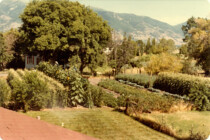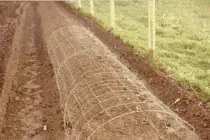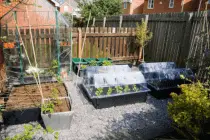Survival Gardening: Part 1

Supply Chain
In our modern society these basics come to us generally without much thinking, they are easily obtained
and take little effort. As we talk about in our training programs,
modern civilization has made the basics of life inexpensive and very
convenient, however, there is a trade off, the supply chain is easily
interrupted due to a whole host of reasons. Food
comes to us from all over the world now, economic difficulties or
transportation issues could quickly deprive us of this vital element in
our survival.
obtained
and take little effort. As we talk about in our training programs,
modern civilization has made the basics of life inexpensive and very
convenient, however, there is a trade off, the supply chain is easily
interrupted due to a whole host of reasons. Food
comes to us from all over the world now, economic difficulties or
transportation issues could quickly deprive us of this vital element in
our survival.It is best to have storage of food and other necessities for up to a year if possible in order to get all the way through a season of difficulty. One inexpensive and simple way to build that storage is to grow much of it yourself with seeds and a garden. Outside our building at Wilderness Innovation are two planters about 6 feet long and 2 feet wide. Last year I put in 5 tomato cages, each 2 feet in diameter and 4 feet high that I made out of field fence wire. We easily got over 600 pounds of tomatoes. The plants cost me about $5 and there was little other expense to grow them. We chose to make salsa out of most of them, since we can use it in so many things. This is an example of how you can grow a lot in a little bit of space. (See book – Gardening When It Counts: Growing Food in Hard Times)
Start Small
I believe it is vital for everyone to grow some food where they live, no matter how small an amount.
It used to be that all people grew food, they had to, that’s what they
ate, they preserved it to get through the winter. Everyone should
know how to grow food, and the best way to do that is to do it, and do
it every year. I’m not a big fan of buying cans of anything that are
supposedly good for 20 or 30 years, it’s too much of a gamble for me,
if it doesn’t work and you need it, it’s too late! If you just grow
what you can every year and replenish your seeds every year you will always be ready for one season.
amount.
It used to be that all people grew food, they had to, that’s what they
ate, they preserved it to get through the winter. Everyone should
know how to grow food, and the best way to do that is to do it, and do
it every year. I’m not a big fan of buying cans of anything that are
supposedly good for 20 or 30 years, it’s too much of a gamble for me,
if it doesn’t work and you need it, it’s too late! If you just grow
what you can every year and replenish your seeds every year you will always be ready for one season.What do you grow? If you haven’t gardened before, start small with just a few things you like. Peas are great and they can start when it’s still cool. Then you can grow bush beans, carrots or potato’s. If you are in the U.S., you can contact the local Extension Service office and find out what’s best in your area and get helpful tips on when to start and what the favored varieties are, also guys like me blog and make videos that may be helpful. Years ago I took a Master Gardener certification course, after graduation I taught classes, and wound up starting my own Market Garden where we sold from a stand on the road.
You don’t have to go big though, some people don’t have much space available, I lived in a city in
 the
South East US for a while and had little room to grow a garden, but
found that I could block some sections among our flowers with bush
beans or peas, it worked well and we got a pretty good harvest. We also
planted some useful herbs among our flowers. There are lots of ways
to grow a garden, the best thing is to grow whatever you can and do a
little gardening every year to keep in practice. Stay tuned for more
helpful advice.
the
South East US for a while and had little room to grow a garden, but
found that I could block some sections among our flowers with bush
beans or peas, it worked well and we got a pretty good harvest. We also
planted some useful herbs among our flowers. There are lots of ways
to grow a garden, the best thing is to grow whatever you can and do a
little gardening every year to keep in practice. Stay tuned for more
helpful advice.

No comments:
Post a Comment